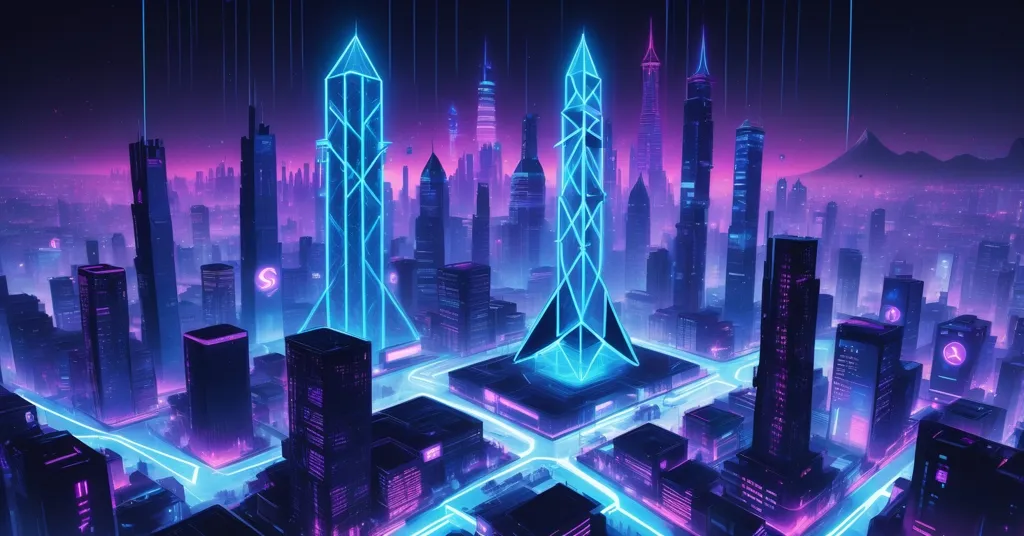Immutable X Overtakes Ethereum in NFT Sales: Layer-2 Dominates with $5M Surge

Immutable X Surpasses Ethereum in NFT Sales: Layer-2 Steals the Spotlight
A jaw-dropping shift has rocked the NFT market as Immutable X, a Layer-2 scaling solution built on Ethereum, has overtaken the blockchain behemoth in daily NFT trading volume. Clocking in at $5 million in sales over a 24-hour period with a 62% surge, Immutable X has edged out Ethereum’s $4 million, which saw a 21% dip. This marks the first time in 2025 that Ethereum has lost its crown, raising big questions about scalability, cost, and the future of NFTs.
- Immutable X’s Lead: $5 million in NFT sales, up 62%, surpassing Ethereum.
- Ethereum’s Slip: $4 million in sales, down 21%, losing top spot in 2025.
- Layer-2 Power: Signals a shift to scalable, low-cost platforms for NFTs and gaming.
Immutable X’s Meteoric Rise: What’s Behind the Numbers?
Let’s break this down. Immutable X, launched in March 2021, isn’t just another blockchain—it’s a specialized Layer-2 solution designed to fix Ethereum’s biggest headaches: sky-high gas fees and slow transaction speeds. For those new to the game, think of Layer-2 as a fast highway built over a congested city street (Ethereum’s main chain). It handles traffic more efficiently while still tapping into the city’s secure foundation. Focused on NFTs and blockchain gaming, Immutable X offers near-zero gas fees and instant trades, a godsend for users tired of Ethereum’s wallet-gouging costs. Minting an NFT on Ethereum can feel like highway robbery—$50 in fees for a $10 asset? Hard pass. Immutable X steps in with a smirk, delivering a cheaper, smoother ride.
The proof is in the pudding. Data from CryptoSlam.io, a multi-chain NFT data aggregator, shows Immutable X’s $5 million in daily sales driven by powerhouse gaming collections. Guild of Guardians Heroes 2 raked in $3.1 million (up 70%), while Guild of Guardians Avatars 3 added $1.4 million (up 50%). Other projects like Gods Unchained and Somnis Card are also fueling the fire. If you’re scratching your head, Guild of Guardians is a blockchain-based game where players own and trade in-game assets as NFTs—a perfect fit for high-frequency, low-cost transactions. This isn’t just a fluke; it’s a clear sign that blockchain gaming NFTs on Immutable X are hitting a sweet spot Ethereum can’t touch right now. For more on these numbers, check out the latest trends and data verification.
Why Gaming NFTs Thrive on Layer-2 Solutions
Digging deeper, gaming NFTs are uniquely suited to platforms like Immutable X. In traditional NFT markets, you might buy a piece of digital art or a collectible once and hold it. But in blockchain gaming, players are trading items—think weapons, skins, or avatars—dozens of times a day. On Ethereum, each trade could slap you with a $20 fee, turning a $5 in-game purchase into a money pit. Immutable X, using tech like StarkWare’s zk-rollups (a method to batch thousands of transactions into one tiny proof on Ethereum’s chain), slashes those costs to pennies and speeds things up to near-instant. While exact transaction data for Guild of Guardians isn’t public, it’s safe to bet gamers are flocking to a platform where trading doesn’t bankrupt them. This niche—high volume, low individual value—is where Layer-2 scaling solutions shine, and Immutable X is eating Ethereum’s lunch in this arena. Learn more about their success factors in gaming NFTs.
Ethereum’s Stumble: Fees and a Fight to Stay Relevant
While Immutable X basks in the glow, Ethereum’s taking a hit. Its $4 million in daily NFT sales is still hefty, but a 21% drop hints at a growing exodus, especially for smaller, frequent trades like those in gaming. Ethereum’s dominance in high-value NFTs—think Bored Ape Yacht Club or CryptoPunks, often called blue-chip projects for their established worth—keeps it central, but its flaws are glaring. High gas fees and scalability bottlenecks make it a nightmare for casual users. Tried buying an NFT during a hyped drop? Good luck swallowing a $100 fee for a simple click. It’s a slap in the face to small-time traders, and Layer-2 platforms are swooping in to capitalize on that frustration. For a broader look at this shift, see how scalability and fees are impacting market share.
But don’t count Ethereum out. Its struggles are growing pains in a maturing ecosystem. Upcoming upgrades could turn the tide—sharding (splitting the network’s data to process faster), rollups (bundling transactions to cut costs), and post-Merge improvements (tweaks after its 2022 switch to energy-efficient staking) aim to tackle these issues head-on. Take Danksharding, slated for 2026; experts suggest it could slash fees by a significant margin, though exact figures are speculative. If Ethereum nails this, it might claw back market share from Layer-2s like Immutable X. For now, though, it’s playing catch-up in the cost-efficiency race. Explore more on how Layer-2 solutions are shaping Ethereum’s NFT trends.
Token Troubles Amid Triumph: The IMX Price Paradox
Here’s a head-scratcher: while Immutable X’s platform is soaring, its native token, IMX, is tanking. Recent data shows IMX slipping below its 50-day Exponential Moving Average to a low of $0.50, down from a peak of $0.81 earlier in 2025. Charts point to more pain, with a potential drop to $0.3458 if support levels break. For non-traders, that’s just a fancy way of saying the price looks rough, despite killer platform stats. Why the disconnect? Token value often dances to the tune of speculation, broader market trends (like Bitcoin dips), or project-specific hiccups (think token unlocks flooding supply). It’s a gut check—platform adoption doesn’t guarantee “number go up.” Does a falling token shake your trust in Immutable X? That’s for you to weigh, but it’s a reminder crypto’s a messy beast. Dive into community thoughts on why Immutable X is leading over Ethereum despite token woes.
The Broader NFT Landscape: Competitors and Bitcoin’s Sideline
Zooming out, other blockchains are vying for a piece of the NFT pie, though they trail Immutable X and Ethereum. Mythos Chain sits third with $2 million in daily sales, Polygon fourth at $1.7 million, and—believe it or not—Bitcoin at $1.3 million, ranking fifth. Bitcoin dipping into NFTs via projects like Ordinals is a curious footnote. As a Bitcoin maximalist, I’ll cheer its purity as digital gold any day; let’s not muddle its mission as a decentralized store of value with flashy dApps or collectibles. That said, seeing experimentation on Bitcoin’s chain is a nod to diversity in this space. Immutable X, Polygon, and even Solana (a Layer-1 NFT contender) are filling gaps Bitcoin shouldn’t—and doesn’t need to—address. From a decentralization standpoint, that’s a win; no single chain can or should do it all. Check out further discussion on Immutable X surpassing Ethereum in community forums.
Speaking of competition, how does Immutable X stack up against peers like Polygon, another Ethereum Layer-2? While Polygon uses a sidechain approach (a separate chain linked to Ethereum), Immutable X’s zk-rollups offer tighter security by proving transactions directly on Ethereum’s mainnet. Both cut fees, but Immutable X’s laser focus on gaming NFTs gives it an edge in that niche over Polygon’s broader dApp scope. Meanwhile, Solana’s fast, cheap Layer-1 setup poses a threat to all Ethereum-based solutions, though its history of outages raises reliability flags. This layered rivalry shows the blockchain space evolving at breakneck speed.
Navigating Risks: The Dark Side of NFT Hype
Before we get too starry-eyed over Immutable X’s rise, let’s ground ourselves. The NFT market is still a Wild West riddled with scams. Recent FBI warnings about airdrop frauds—fake “free” NFTs that steal your wallet if you share seed phrases—remind us the hype train often derails. While unrelated to Immutable X, these scams (costing millions in 2025 per Chainalysis estimates) highlight a broader risk. Low-cost platforms like Immutable X could attract bad actors peddling fake gaming NFTs, preying on eager users. Our stance? No tolerance for grifters. Vet every project like your wallet depends on it—because it damn well does. If it smells like a moonshot promise or asks for your private keys, run. We’re here for real innovation, not snake oil.
What’s Next for Layer-2 Solutions and NFTs?
Immutable X’s surge is a loud endorsement of Layer-2 scaling solutions and a challenge to Ethereum’s old guard. It’s also a masterclass in niche innovation—blockchain gaming NFTs, with their community buzz and relentless transaction pace, are a goldmine, and Immutable X is mining it like a pro. I’m thrilled to see alternatives push the crypto revolution forward, embodying effective accelerationism by disrupting bloated systems. But let’s not get carried away. Ethereum remains the heavyweight champ with an unmatched developer ecosystem, and its upgrades loom large. Plus, Immutable X’s token woes and the NFT market’s scam minefield keep us on edge. This feels like the opening salvo in a broader Layer-2 uprising. Who’s next to shake the throne? For deeper insights into specific collections, read up on Guild of Guardians performance analysis, and for the latest updates, see how Immutable X flipped Ethereum in sales volume.
Key Takeaways and Questions on Immutable X’s NFT Surge
- What is Immutable X, and why is it leading in NFT sales?
Immutable X is a Layer-2 solution on Ethereum, launched in 2021, offering near-zero gas fees and instant trades for NFTs and gaming. Its $5 million in daily sales (versus Ethereum’s $4 million) reflects users choosing cost-effective platforms, especially for gaming NFTs like Guild of Guardians.
- Is Ethereum’s dominance in the NFT market over?
Not yet—Ethereum’s strength in high-value NFTs and its developer base keep it vital. But Layer-2 solutions like Immutable X are chipping away at cost-sensitive niches. Future upgrades could help Ethereum fight back.
- Why are gaming NFTs driving Immutable X’s success?
Gaming NFTs involve frequent, low-value trades—perfect for Immutable X’s cheap, fast transactions. On Ethereum, fees make this unviable, pushing gamers to platforms where trading a $5 item doesn’t cost $20.
- What’s behind the IMX token price drop despite platform growth?
IMX has fallen to $0.50 with bearish signals, likely due to market speculation or broader crypto trends, not platform performance. Token value often diverges from real usage in crypto.
- How does Bitcoin fit into the NFT market compared to Immutable X?
Bitcoin’s NFT volume is $1.3 million daily, ranking fifth, showing it’s a minor player focused on store-of-value over NFTs. Immutable X’s gaming focus gives it a clear edge in this space.
- What risks should NFT traders watch for in this hype?
Scams are everywhere—fake airdrops and phishing for wallet keys have cost millions in 2025. Low-cost platforms might attract fraudsters, so vet every NFT project ruthlessly.
- How do Layer-2 solutions like Immutable X impact Ethereum’s future?
Layer-2s ease Ethereum’s scalability woes, but they also split user bases. If Ethereum’s upgrades lower fees, it might reclaim dominance; if not, Layer-2s could redefine the NFT landscape.



